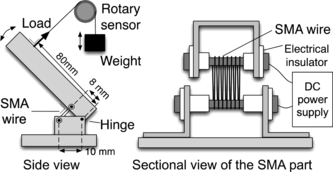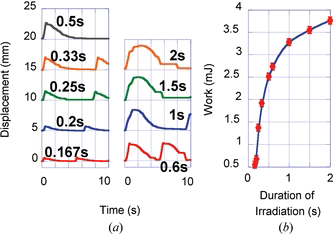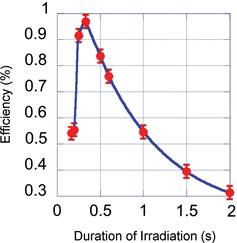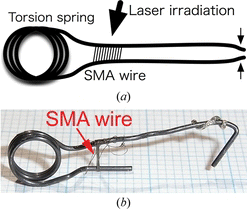Abstract
With the aim of manipulating macroscopic objects, the possibility of improving energy conversion efficiency of light-driven actuators (LDAs) was investigated. Thermal expansion is one of the most efficient mechanisms reported so far but a rough estimation revealed that its upper limit in efficiency is ∼10−4%. Thermodynamics suggests several percent can be achieved in theory, so by using a suitable mechanism there is room for improvement. Based on those considerations we propose a LDA using a pre-tensioned wire of shape memory alloy. This design reduces the energy loss in converting the input light into mechanical motion. We demonstrated that a force larger than 1 Newton and an energy conversion efficiency of 1 percent can be achieved.
NOMENCLATURE
| c | = |
specific heat |
| E | = |
Young's modulus |
| F | = |
force |
| J | = |
heat inducing thermal expansion |
| L | = |
initial length |
| L′ | = |
final length |
| S | = |
cross-section of the material |
| T C | = |
temperature of the cold reservoir |
| T H | = |
temperature of the hot reservoir |
| W | = |
mechanical work due to thermal expansion |
| α | = |
linear thermal expansion coefficient |
| ΔL | = |
increase in length |
| ΔT | = |
temperature increase of |
| ε | = |
strain |
| ηte | = |
upper limit of efficiency due to thermal expansion |
| ηth | = |
efficiency due to thermodynamics |
| σ | = |
stress |
| ρ | = |
mass density |
| t | = |
time |
1. INTRODUCTION
Light-driven actuators (LDAs) realize non-contact actuation of objects enabling several new applications. Various approaches have been reported using physical phenomena such as radiation pressure (Ashkin, Citation1970), photothermal effect, photochemical reaction (Yu et al. Citation2003), photoinduced phase transition (Ikehara et al. Citation2001), and photostrictive effect (Poosanaas et al. Citation2000). The material bends, shrinks, or stretches, and subsequently these changes are converted into a usable form of mechanical motion. LDAs are particularly useful for microscopic manipulation, where conventional actuators cannot be used. However, the peculiar characteristics of LDAs, such as non-contact actuation of objects and simple and lightweight structures, potentially open up several new applications where handling of larger objects is involved. The problem in applying LDA for larger objects is their inefficiency. Energy conversion efficiency, defined as the ratio between the output work and the input light energy of the actuator, of a LDA is typically in the order of 10−5% to 10−10% (Okamura, Citation2006). For instance, the efficiency of polymer polyvinylidene fluoride (PVDF) film LDA was 8.3 × 10−5% (Sarkisov et al. Citation2006), and that of a photothermal optical fiber is 10−6%, as can be estimated from the parameters given in the literature (Inaba, Kumazaki, and Hane, Citation1995). Although efficiency does not represent a limiting factor for actuating microscopic objects, for larger objects it is essential, because such low efficiency would require excessively large laser power. Therefore, in order to allow exploitation of LDAs at the macro-scale, the efficiency needs to be at least in the order of 1%.
In this article we propose a design of LDA that addresses this issue and features an efficiency meeting the previously mentioned requirement. The proposed LDA makes use of shape memory effect. Since it is driven by heat that was induced by light irradiation, it can be regarded as a variant of shape memory alloy (SMA) heat engine. SMA heat engines have been extensively studied since 1970s as an environment-friendly alternative to extract mechanical energy from low-grade energies such as warm wastewater. Various mechanisms have been proposed and theoretical and experimental studies were performed to evaluate energy conversion efficiency. Theoretical prediction of up to 20% of energy conversion efficiency is reported (Wayman and Tong, Citation1975). In an experiment a value of 1–7% has been obtained for NiTi SMA alloy (Mercier and Melton, Citation1981). This was lower than the theoretical prediction of 13% calculated using the chemical and mechanical parameters obtained using the same sample, which was ascribed to non-ideal martensitic transformation. An energy conversion efficiency of up to 2.5% was also assessed by experiment (Tanaka and Saito, Citation1993). The same author also demonstrated a belt type SMA heat engine, which produced output power of 0.2–2.0 W with frequency of rotation up to 400 rpm. The abovementioned energy conversion efficiencies are that of the material itself, and it is also necessary to evaluate efficiencies when they are used in actual heat engine designs. To evaluate SMA heat engines, theoretical models intended for simulation have been developed (Zhu et al. Citation2001; Govindjee and Hall, Citation2000). Energy conversion efficiency of 2–3% has been calculated for the twin crank heat engine (Zhu et al. Citation2001). All the results of these studies suggest 1% of efficiency for LDA is not an unrealistic goal.
In this article we will describe the design of the proposed LDA in detail and evaluate its performance. Following the introduction in Section 1, we will investigate the theoretical limit and the factors that limit the efficiency in Section 2. In Section 3 we will discuss a possible design that could eliminate those limitations and propose a LDA that uses a pre-tensioned shape memory alloy wire actuator. In Section 4 we will discuss other possible forms of LDAs and will summarize in Section 5. Partial results of this work is also described in our recent paper (Yamaguchi et al. Citation2009).
2. THEORY OF ENERGY EFFICIENCY OF PHOTOTHERMAL LDA
2.1. Thermodynamics
The most efficient type of LDAs proposed so far have efficiencies in the order of 10−5%, and they are mostly based on photothermal effect. For those type of LDAs the role of light irradiation is merely to deposit heat, and LDAs are typically designed to return to its initial state after each cycle without leaving any change in the system other than heat, thus the theory for heat engines can readily be applied.
According to thermodynamics, the theoretical limit of the efficiency of a heat engine is given by ηth = 1 − T C/T H where T C is the ambient temperature and T H is the temperature of the heat source. For LDAs that we are considering, T H corresponds to the temperature that is induced by heat deposit due to laser irradiation. Assuming a moderate temperature change of 10 K, for T C = 300 K and T H = 310 K, the maximum efficiency is ηth = 3.2%.
2.2. Factors that Limit Efficiency
As we discussed in the previous section an efficiency of a few percent can be expected for an ideal photothermal effect based LDA, while LDAs reported so far have much lower efficiency. In the following we address the reasons of this gap by considering an LDA where (a) light irradiation causes a temperature increase, then (b) a change in the dimension of the material arises and subsequently, (c) the change is converted into some usable form of mechanical motion.
The loss in energy in step (a) is caused by light reflection and heat loss at the surface. Only the portion of light energy that was absorbed turns into heat and contributes to output work, therefore, absorption coefficient directly links to the energy conversion efficiency. Since absorption coefficient largely depends on the wavelength, it is possible to choose an appropriate wavelength. There are also methods to increase absorption by surface treatment such as oxidization. The heat loss at the surface is caused by conduction and radiation. Some heat is taken away also by air. Heat loss can be minimized by insulation, however, the deposited heat has to be dissipated elsewhere for an LDA to return to its original state after light is turned off, so a careful consideration is necessary. Heat conduction is basically proportional to the temperature difference, and radiation is proportional to the T 4, where T is the absolute temperature of the object, according to Stefan–Boltzmann law. In either case, the energy loss becomes smaller for smaller temperature difference. For a small temperature difference of the order of 10 K heat loss is small and does not account for the large reduction of energy conversion efficiency.
The second step (b) is directly related to the physical phenomenon that is used. In order to roughly estimate the efficiency of thermal expansion as conversion mechanism of heat into mechanical motion, let us consider a situation where a material of length L is heated, experiencing a temperature increase of ΔT, which results into a thermal expansion from L to L′ =L + ΔL = L(1 + αΔT). We assume that the maximum work that this material can exert on an external object during the course of thermal expansion is equal to the work that is required to compress the expanded material to its original length, L. This is the most direct way of exerting force on another object by thermal expansion and therefore will give the largest estimate of work that can be obtained from thermal expansion. Then the maximum energy conversion efficiency, ηte, will be given by the ratio of the maximum work derived under this assumption and the heat which was applied to the material. The stress, σ, is related to the strain, ε = ΔL/L, by σ = εE, where E is Young's modulus of the material. The force, F, is given by F = σS = εES, where S is the cross-section of the material. When we compress the material from length L′ to L, the work, W, is calculated as,
Meanwhile, the energy required to increase the temperature by ΔT is J = ρcLSΔT, where c is the specific heat of the material, and ρ its mass density. The maximum energy conversion efficiency for a simple model of thermal expansion, therefore, is given by, ηte = W/J = α2 EΔT/2ρc. Note that this treatment is a rough estimate, assuming material parameters to be constants. Next, we calculate ηte for copper because it is one of the most suitable materials for thermal expansion based LDA for its large thermal expansion coefficient and thermal conductivity. We substitute E = 120 GPa, c = 0.379 J/g·K, ρ = 8.96 g/cm3, and α = 17 × 10−6/K in the above formula and obtain ηte = 5.1 × 10−6ΔT. For ΔT = 10 K, ηte = 5.1 × 10−3%. The substance of the fiber core that is used in optical fiber LDA (Inaba, Kumazaki, and Hane, Citation1995) was quarts, which has much smaller thermal expansion coefficient. From the above argument, it was revealed that thermal expansion of solids is unlikely to be able to convert heat into mechanical work with energy conversion efficiency better than 10−2%. This seems to account for the low efficiency of LDA reported so far for the most part.
The last part (c) is how much of the induced dimension change can be converted into usable form of mechanical motion. This part also accounts for a large efficiency loss. For instance, for a type of LDA where the substance bends upon irradiation and pushes against a load, a large stress is induced at the base of the material. The material is usually thin and yields easily and cannot produce a large force. This type of LDA include the one using PVDF film (Sarkisov et al. Citation2006) and optical fiber core (Inaba, Kumazaki, and Hane, Citation1995). When choosing the material, materials which experience anisotropic dimension change is in general preferable. Isotropic dimension change such as thermal expansion of isotropic material is difficult to be converted into a motion in a single direction. If the material changes its dimension solely in a single direction, the conversion becomes efficient and it will result in a better energy conversion efficiency.
2.3. Material Choice and Design
From the above considerations, shape memory alloy (SMA) seems to be a good candidate for an efficient LDA. SMA offers large displacement and large force, and there are few actuating mechanisms which produce more useful work per unit volume than SMA (Otsuka and Wayman, Citation1999). For instance, SMA can induce a displacement 10 times larger than that of a bimetal with the same temperature difference. SMA is usually heated by an electrical current and extensive study as actuator has been carried out (Bellouard, Citation2007; Bellouard et al. Citation1998). The idea of using SMA for LDA by photothermal effect is not new (van den Broek et al. Citation2007; Furuya and Tokura, Citation2006), however, the LDA we are proposing in this article use more efficient mode of converting transition of SMA into a mechanical motion, and thus offers much higher efficiency. The SMA we used is an anisotropically organized NiTi-based SMA wire actuator (Toki Corporation BMF series). This wire remembers only its length: when heated from 338 K to 348 K it shrinks over 4% of its original length. Our LDA uses this wire in a manner that the wire pulls a load when heated by light. This pre-tensioned design eliminates the previously discussed problem in step (c) and the performance of the material itself can be fully utilized. Also, due to a small temperature difference, heat dissipation can be kept at a minimum, therefore the energy loss seen in step (a) is also minimized.
The stroke of a wire-based actuator will be directly proportional to the length of the wire, so a longer wire is preferable, however, the use of a thin wire poses a problem of illumination: It is difficult to illuminate a long wire evenly and focusing light onto a wire along its length is virtually impossible. Our solution to this problem is to line up thin wires in parallel, forming a uniform surface area. It is possible to line up wires without any gap between them in theory. Since typical profile of illuminating light is circular, in usual situations a square illumination area will give the best result.
Another important factor that directly links to the conversion efficiency is the reflectivity of the material. Unfortunately no data is available for this specific SMA wire, and since the wire is very thin we were unable to measure it directly. The color of the wire is similar to oxidized metal and it does not possess metallic shine. We will come back to this point later.
3. EXPERIMENT
The schematic and actual photographs of the LDA used in the experiment are shown in Figures and , respectively. It consists of two aluminum channels jointed by a hinge and operates in a scissors-like motion. The length and the width of the upper arm is 100 mm and 15 mm, respectively. The relatively long arm was given in order to facilitate a precise measurement of the displacement. A string is attached to the arm, making a right angle with the arm, at a point 80 mm from the hinge. The other end of the string is attached to a weight, which asserts upward force on the arm through a pulley on a rotary sensor that measures the displacement of the string. The weight provides a tension on the SMA wire which is necessary for it to work. Two steel M3 screws are inserted into each of the two aluminum channels at 8 mm and 10 mm from the hinge and the SMA wire is wound around them 35 times. By winding SMA wire the applicable load increases accordingly. In the present case it is multiplied by a factor of 70 compared with that of a single wire. The wound wire forms a solid surface for light to be absorbed, thereby increasing the efficiency of light reception. The position of the screws are chosen so that the wire makes a right angle with the arm. This was done to facilitate the calculation of the force asserted on SMA. Also, since the SMA wire run approximately at an angle of 45°with a horizontal plane, the projected area of the SMA surface to a vertical plane becomes closer to a square, which is desirable when shining the laser beam horizontally. We chose the wire with a diameter of 50 µm, which is the thinnest one that was available due to a reason that a thinner wire provides a faster response. The rate of heating is proportional to the ratio of the projected surface area on a plane perpendicular to the direction of the laser beam to the volume of the wire. For cooling, the rate of heat transfer to the surrounding air is mostly determined by the ratio of the total surface area to the volume of the wire. In either case a thinner wire offers a faster response. The disadvantage of using thin wire is that it can withstand a smaller force, however, this is not a problem since the force it can withstand is multiplied when a wire is wound. The screws that hold the wire have much larger heat capacity than the wire and act as heat sinks and also contribute toward reducing the response time. They are electrically insulated from the frame by means of nylon insulators, and electrical terminals are attached to them so that electrical current can be applied to the wire.
Figure 2 (a) The photograph of the light-driven actuator. The SMA wire is indicated with a circle. (b) The close-up view of the circled area.
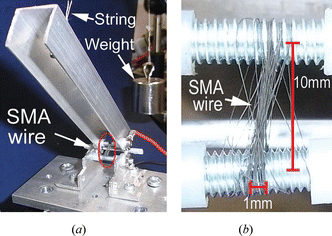
In the experiment, a cw Argon-ion laser source (Spectra-Physics Model 164 Ar ion laser) was used as the light source. Laser power was kept at 1.0 W throughout the experiment. An unfocused laser beam shined the densely packed part of the SMA wire from the front side of the LDA. The beam diameter at the SMA wire surface was about 2 mm. The width of the wound SMA wire was about 1 mm and was narrower than the laser beam diameter. By observing the beam profile with a CCD camera (Thorlabs DC210), it was found that roughly 60% of the total power of the light fell upon the SMA wire. The reason for using unfocused laser beam was to obtain a uniform illumination as much as possible for evaluation of LDA. If one wishes to receive all of the light energy it can be realized simply by winding the wire more. Also, the laser beam did not cover the whole length of the SMA part, resulting in a shorter stroke of the LDA. A larger stroke will be obtained by adjusting the distance between the two screws. Since laser beam only covered the wire partly, when the wire contracted and the angle of the wire changed, the amount of light energy received remained unchanged. As can be seen from the above arguments, the advantage of our design is that the light reception area can be tailored to match the profile of illuminating light.
The LDA operated simply by shining laser beam. When shined by laser beam the upper arm of LDA immediately went down by a few millimeters (Figure ). When the laser beam is cut off it returned to its original position. Applying a weight takes up the slack but a stretch of the wire was not observed. A good reproducibility was confirmed (Figure ). Figure (a) shows the measured travel for various weights. Irradiation was performed until the SMA wire fully contracted.
Figure 3 Photographs of LDA (a) before and (b) under irradiation. The difference in height between the two photographs is shown with a thick line.
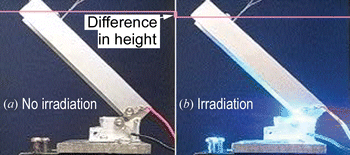
Figure 4 Measured displacement induced by repeated irradiation of laser beam. The weight used was 100 g. The duration of light illumination are shown by horizontal bars in the bottom of the plot. The electrical power applied to SMA is also shown, indicating it was almost constant during the process.
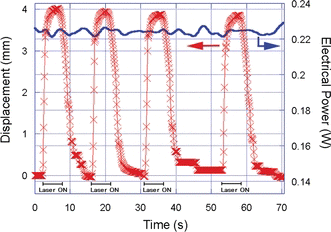
Figure 5 (a) Displacements under different loads as a function of time. The results for the weight of 50–125 g are displaced shifting 5 mm from each other to avoid overlapping. (b) Work done for one cycle by the actuator calculated from (a).
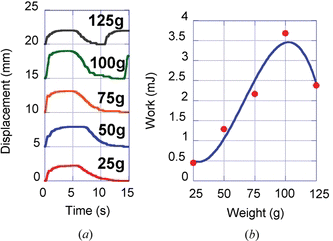
Although there was no need for applying electrical current, a small constant electrical current was applied in the experiment. This was done to raise the SMA wire's initial temperature near its transition temperature of 338 K. The current was adjusted to just below the point where the LDA started to react. After the adjustment the electrical power was about 0.2 W. As will be explained later, this was done in order to assess the conversion efficiency accurately. The current and voltage were monitored and its change during operation was in a negligible range (Figure ). No noticeable difference was observed in the operation of LDA with and without the electrical current.
The output work was measured by measuring the distance the LDA lifted up a certain weight. The displacement was measured with a rotary motion sensor (Pasco Scientific CI-6538) and the output was computed by calculating the increase in the potential energy of the weight (Figure ). The mass of the aluminum channel was also taken into account in the calculation. As the load exceeded 100 g, the maximum displacement and the calculated work started to drop (Figures 5(a) and 5(b)). With a 100 g load, the maximum displacement was 4 mm, the output work was 3.7 mJ, and rise and fall times were respectively 0.5 s and 2 s. Based on this result, a 100 g weight was used to examine the performance of the LDA under different duration of irradiation. The time duration of irradiating the SMA wire was controlled by a computer controlled shutter (Copal corp.) (for t ≥ 0.6 s) and a light chopper (NF Electronic Instruments 5584A) (for t < 0.6 s). The results are shown in Figure (a) and the calculated output work is in Figure (b).
4. DISCUSSION
4.1. Performance of the Prototype LDA
The maximum work produced was 3.7 mJ with 0.5 s response time. The actuator can continuously operate in a cycle of about 4 s where 0.33 s is used for irradiating the wire with the laser beam. If one revolution of the motor is achieved from one cycle of the LDA, 15 revolutions per minute are possible, and an output power of roughly 0.5 mW is expected. Conversion efficiency was calculated by the ratio of the performed work and the irradiated light energy. The LDA contracts by light irradiation and when it is turned off it is moved back to its original position by the external weight. In the calculation we evaluated the output work from the contraction part only, although there is a possibility that some work output can be extracted from this return process as well. For determining the irradiated light energy, only the portion of light that actually fell upon the wire was taken into account. The effect of applied electrical current was not included in the calculation. Since the transition temperature is higher than the room temperature by 50 K, without an electrical current a fraction of incident light energy will be used to increase the temperature to the transition temperature, which does not contribute to the output work. This is not an intrinsic loss: If the experiment was performed in a higher temperature this would not be necessary. Also, it is possible to fabricate SMA with a transition temperature near the room temperature. The calculated energy conversion efficiency is shown in Figure . It yielded a maximum efficiency of 0.97% under a load of 0.98 N and at irradiation duration of 0.33 s. To our knowledge, this is by far the largest value compared to the LDAs reported so far, and is at a level where practical application is possible. The theoretical limit of this LDA's conversion efficiency is calculated to be 2.9%, assuming T C and T H of 338 K and 348 K, respectively. Therefore, the efficiency of this LDA is already fairly close to the theoretical limit.
In our experiment a large asymmetry in the rising and falling times was observed. This does not affect the energy conversion efficiency, however, it affects the output power. This can be improved by increasing the heat dissipation rate for cooling. Ordinary measures such as heat sink or air circulation will be effective for that purpose.
From the experimental result, reflectivity of this SMA wire was estimated to be better than 8%. The wire started to respond in less than 0.5 s without electrical current for pre-heating. This means the temperature increased from room temperature to close to the transition temperature, which is about 50 K of increase, in that time period. The energy required to increase the temperature by 50 K in martensite phase was calculated to be 25 mJ for the experimental condition using the date found in the literature (Otsuka and Wayman, Citation1999). The light energy falling on the SMA wire was 600 mW, therefore, at least 8% of light energy turned into heat.
4.2. Alternative Designs
In Figure , another prototype of LDA based on the same principle is shown. It has a torsion spring to apply a tension to the SMA wire actuator. The wire is simply wound around two antennas of the torsion spring. A fast operation and small dimension can be achieved. This design can be used for the tweezers application.
To obtain a larger stroke without making the irradiation area longer, a design shown in Figure might be used. In this design a single wire is wound around a tapered spindle, or stacked pulleys of different radius. The relationship between rotation angle and displacement is different at each location when a wire shrinks, but the tapered design allows this difference to be adjusted. Alternatively, if the pulleys are made to rotate independently, their radius can be identical.
5. CONCLUSIONS
Based on considerations of factors degrading the energy conversion efficiency, we proposed a light-driven actuator capable of actuating macroscopic objects using pre-tensioned wire actuator based on NiTi shape memory alloy of a diameter of 50 µm. The use of pre-tensioned wire made it possible to avoid concentration of stress, and enabled large load to be applied. With 1.0 W Argon-ion laser beam, this actuator produced work of 3.7 mJ with 0.5 s response time. The efficiency was 0.97% when a load of 0.98 N was applied. High efficiency can be ascribed to use of shape memory alloy, suitable coupling of a material's state change with the actuating mechanism, and low heat dissipation.
REFERENCES
- Ashkin , A. 1970 . Acceleration and trapping of particles by radiation pressure . Phys. Rev. Letter 24 : 156 – 159 .
- Bellouard , Y. , R. Clavel , R. Gotthardt , J. E. Bidaux , and T. Sidler . 1998 . A new concept of monolithic shape memory alloy micro-devices used in micro-robotics . Paper read at Proceedings of Actuator 98 6th International Conference on New Actuators. Bremen, Germany. Small Business, Technol Eur Affairs 17–19 June 1998.
- Bellouard , Y. 2007. Shape memory alloys for microsystems: A review from a material research perspective. Materials Science and Engineering A 481–482:582–589.
- Furuya , S. and H. Tokura . 2006 . Local heating and local transformation of a shape memory alloy foil by laser irradiation . Journal of the Japan Society for Precision Engineering. Supplement. Contributed Papers 72 ( 2 ): 203 – 207 .
- Govindjee , S. and G. J. Hall . 2000 . A computational model for shape memory alloys . International Journal of Solids and Structures 37 ( 5 ): 735 – 760 .
- Ikehara , T. , M. Tanaka , S. Shimada , and H. Matsuda . 2001 . Optically-driven polymer actuator using reversible photo-induced phase-transition phenomena . SPIE-Int. Soc. Opt. Eng. Proceedings of the SPIE – The International Society for Optical Engineering 4234 : 215 – 222 .
- Inaba , S. , H. Kumazaki , and K. Hane . 1995 . Photothermal vibration of fiber core for vibration-type sensor . Japanese Journal of Applied Physics, Part 1 (Regular Papers & Short Notes) 34 ( 4A ): 2018 – 2021 .
- Mercier , O. and K. N. Melton . 1981 . Theoretical and experimental efficiency of the conversion of heat into mechanical energy using shape-memory alloys . Journal of Applied Physics 52 ( 2 ): 1030 – 1037 .
- Okamura , H. 2006 . Laser motor . Proceedings of the SPIE – The International Society for Optical Engineering 6374 : 637401-1 – 10 .
- Otsuka , K. and C. M. Wayman . 1999 . Shape Memory Materials . Cambridge , UK : Cambridge University Press .
- Poosanaas , P. , K. Tonooka , and K. Uchino . 2000 . Photostrictive actuators . Mechatronics , 10 ( 4–5 ): 467 – 487 .
- Sarkisov , S. S. , M. J. Curley , L. Huey , A. Fields , and G. Adamovsky . 2006 . Light-driven actuators based on polymer films . Optical Engineering 45 ( 3 ): 34302-1 – 10 .
- Tanaka , M. and K. Saito . 1993 . Fundamental study on energy conversion system using shape memory alloy . Journal of Mechanical Engineering Laboratory 47 ( 6 ): 257 – 271 .
- van den Broek , P. J. , B. Potsaid , Y. Bellouard , and J. T. Wen . 2007 . Laser actuated shape memory alloy mobile micro-robot: initial results . Paper read at Optomechatronic Actuators and Manipulation III . Lausanne , Switzerland . 8 Oct. 2007 . 6715 : 67150A-1 – 8 .
- Wayman , C. M. and H. C. Tong . 1975 . On the efficiency of the shape memory effect for energy conversion . Scripta Metallurgica 9 ( 7 ): 757 – 760 .
- Yamaguchi , K. , R. Ono , and H. Okamura . 2009 . Light-driven actuator with energy conversion efficiency in the order of 1% . App. Phys. Express 2 ( 3 ): 034502 .
- Yu , Y. , M. Nakano , and T. Ikeda . 2003 . Directed bending of a polymer film by light . Nature 425 : 145 .
- Zhu , J. J. , N. G. Liang , K. M. Liew , and W. M. Huang . 2001 . Energy conversion in shape memory alloy heat engine. I. Theory . Journal of Intelligent Material Systems and Structures 12 ( 2 ): 127 – 132 .
